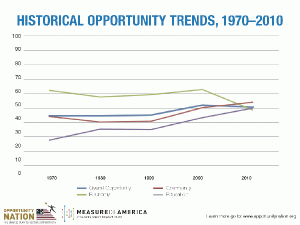Congrats, America. You Have Less Opportunity Than 1970
 •
•
Jim Tankersley, Reporter
Americans today have more social and educational opportunity than they did 40 years ago — but they have less economic opportunity, thanks to a bruising recession and the alarming economic trends that preceded it.
That’s the sobering conclusion of a detailed study out today from Opportunity Nation and Measure of America, which quantifies the evolution in community, educational and economic opportunity from 1970 to 2010.
The Historical Report of Opportunity sizes up the nation’s progress on 10 factors, including school graduation, violent crime, poverty, access to health care, jobs, wages and economic inequality. The report factors each component into an overall score called the Opportunity Index. That index, the report finds, has increased over the decades, meaning the United States as a whole enjoys more opportunity today than it did four decades ago.
But the findings include two red flags for policymakers: Opportunity overall decreased from 2000 to 2010, largely because the economic component of the index is lower now than in any previous decade.
The report blames the Great Recession for “part but not all of this poor performance.” It notes that wages have fallen over the last decade and inequality has risen steadily across the country since 1970, for example; it calls the inequality increase “evidence of one of the structural changes in the American economy over the past several decades that has slowly eroded economic opportunity.”
The states with the most — and least — opportunity
The report also shows how misleading it can be to think of opportunity as a nationwide phenomenon. Recent economic research has shown economic mobility varies widely across states and metropolitan areas. The Opportunity Index is no different: States began in 1970 with wildly varying opportunity scores, and they have improved (or in the case of Nevada and Michigan, fallen back) at different speeds since then.
Leading the pack for improvement is Virginia, which has seen big advancements in income and high-school graduation, and big reductions in poverty and violent crime.
It’s hard to draw a clean “red-state/blue-state” distinction between the other big gainers of the last 40 years. The Top 10 states for opportunity improvement also include liberal bastions Vermont, Massachusetts and Maryland (along with the District of Columbia); conservative bastions Arkansas, North Dakota, Kentucky and Louisiana; and swing-state New Hampshire.
The Bottom 10, by improvement, is similarly eclectic: Delaware, Wisconsin, California, Utah, Ohio, Hawaii, Indiana, Arizona, Michigan and Nevada.
The key to improving opportunity
For the nation as a whole, the best news in report – and a big driver of the overall improvement in opportunity – is education. The score for preschool enrollment across the country has almost quadrupled since 1970. For adults earning an associate’s degree or more, it’s doubled. Many of the lowest-scoring states for education 40 years ago made huge strides by 2010, including Alabama, Mississippi, West Virginia and the Carolinas.
Violent crime has fallen since 1980 across the country, though it remains worse than it was in 1970. Access to medical care has improved dramatically. Perhaps surprisingly, in 2010 there were fewer Americans aged 16-24 who were not in school or working than there were 40 years ago.
There are lessons to be mined here for policymakers, particularly in close study of the states that have improved – and how they’ve improved. “Expanding opportunity requires creating conditions for success in communities,” the report concludes, adding: “While external economic shocks like the decline in manufacturing and the Great Recession may have had an impact on the opportunity landscape in such places, the policy decisions of the last four decades likely have also played an important role and deserve further exploration.”









